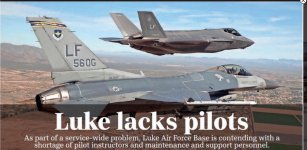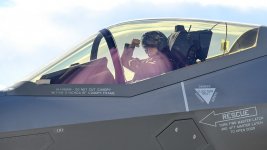https://theaviationist.com/2019/02/16/the-first-reports-of-how-the-f-35-strutted-its-stuff-in-dogfights-against-aggressors-at-red-flag-are-starting-to-emerge/#disqus_thread
The First Reports Of How The F-35 Strutted Its Stuff In Dogfights Against Aggressors At Red Flag Are Starting To Emerge - 16 Feb 19
Red Flag 19-1 has just come to an end and, based on official reports, once again the F-35 held its own against the Aggressors
You may probably remember what happened in 2017, when the first F-35A jets, belonging to the 388th and 419th Fighter Wings at Hill AFB, Utah, deployed to Nellis Air Force Base, Nevada, to take part in the type’s first Red Flag exercise. During that iteration, designated RF 17-1, the U.S. Air Force F-35A Lightning II, who had just been declared IOC (Initial Operational Capable) achieved a resounding score in mock aerial engagements against Aggressors: while early reports suggested a 15-1 kill ratio a subsequent Air Force testimony by Lt. Gen. Jerry D. Harris, Vice Commander of Air Combat Command characterized the kill ratio as “20-1” meaning that, for one F-35A “lost” in simulated combat in a high threat environment that the aircraft destroyed 20 simulated enemy aircraft.
This is what we wrote about the impressive F-35 performance:
Three words summarize the role of the F-35A during this Red Flag exercise; stealth, integration and flexibility. To a greater degree than any previous aircraft in U.S. Air Force history the F-35A Lightning IIs from Hill AFB acted as sensors, guidance platforms and strike assets almost simultaneously, and they did so in a threat environment that would have been previously impenetrable without significantly greater loses. They also performed in an air-to-air role: although we don’t know the ROE (Rules of Engagement) in place for the drills nor the exact role played by the F-22 Raptors that teamed up with the Lightning II throughout the exercise, the results achieved by the F-35, appear to be impressive, especially considering the 5th Gen. aircraft’s additional tasking during RF.
Indeed, while early reports suggested a 15-1 kill ratio recent Air Force testimony by Lt. Gen. Jerry D. Harris, Vice Commander of Air Combat Command characterized the kill ratio as “20-1” meaning that, for one F-35A “lost” in simulated combat in a high threat environment that the aircraft destroyed 20 simulated enemy aircraft belonging to the “Red Force”.
Two years later, with the subsequent Block 3F software upgrade available that provides 100 percent of the software required for full warfighting capability, the F-35s have once again put their skills to test as part of the “Blue Force” at the Air Force’s premier air combat exercise held at Nellis AFB: an “exponentially more challenging” Red Flag, according to the airmen from the 388th Fighter Wing’s 4th Fighter Squadron. The squadron brought 12 aircraft and more than 200 Airmen to the three-week exercise – pilots, maintainers, intelligence officers, weapons crews, and support personnel, including reservists from the 419th Fighter Wing.
The three-week exercise has just come to an end. However, as expected, some initial details about the results achieved by the F-35s have started to emerge in public statements and news releases. “The first time I came to Red Flag in 2004, our tactics were the same as they had been since the early 1980s. Now, the threat and complexity are at a whole different level,” said Col. Joshua Wood, 388th Operations Group commander, in a 388th FW Public Affairs article. “It’s no longer assumed that we will gain and maintain air superiority. That’s a big shift.”
We have provided details about what taking part in a RF means to an airman and how this exercise has changed throughout the years in this past article written by a pilot who went twice to Red Flag. Here’s an excerpt:
In 2002 we had a well-defined set up, we knew where the enemy was, how it would react to our presence, where the threats were located etc.; in 2010, we faced a “border line” scenario with enemy elements embedded in friendly forces or civilian population, where CDE (Collateral Damage Estimation) was extremely important, where target VID (Visual IDentification) or EOID (Electro Optical IDentification) were the main success factors in the simulated air campaign. In other words, 8 years apart, the RF scenario had evolved to adapt to the ever-changing “combat environment.”
The most recent RFs prove that the exercise continues to change. For instance, while maintaining the standard coalitions scheme (Blue and Red forces), RF 17-1 had the two teams involved in a “crisis” instead of a war situation. On top of that, not only does the scenario has introduced the latest and most sophisticated and capable threats that require a change in tactics, but it has also moved on a higher level, focusing on the importance of “battlefield information management,” a kind of task the much debated F-35 is going to master.
Today, taking part in a RF means joining pilots, ground forces, intelligence analysts, cyber and space operators, for testing and training operations at Nellis as well as the Nevada Test and Training Range north of Las Vegas. All the participants have only one goal in mind: working together to FITS “Find, Identify, Track and Strike” the adversary, to attack forces in a multi-domain battlefield which is based on what we have encountered so far in theater and what we may expect to find in the future wars. This is the real core business and the big change of the most recent RFs.
A RF mission is usually made of 20-25 adversaries: not only aircraft, but also ground-to-air threats, moving and unknown threats etc. In other words, the old fixed scenario has become much more “dynamic” requiring a real-time “combat battlefield” coordinator. Therefore, the most recent RF scenarios aim to develop the ability to fuse all the combat capabilities. In this context, the F-35 brings to the package the ability to penetrate deep into the most complex and “unknown” environments providing the “overall control” of the battlefield. The F-35, as well as any other modern aircraft with similar sensor fusing ability, can also work in a complementary fashion with the 4th generation fighters, sharing the information with all the other “players” while providing its own amount of fire power to the team.
Stealth technology (capability to survive and operate effectively where others cannot) combined with 5th generation features (i.e. superior information management), were pivotal to achieve the overall RF’s mini-campaign results.
Therefore, Red Flag keep changing, and F-35s play an important role in missions flown in “contested or denied” environments with active electronic attack, communications jamming, and GPS denial. “Those situations highlight the fifth-generation capabilities of the F-35. We’re still able to operate and be successful. In a lot of cases we have a large role as an integrated quarterback,” said Lt. Col. Yosef Morris, 4th Fighter Squadron commander. “Our ability to continue to fuse and pass information to the entire package makes every aircraft more survivable.” Indeed, we have often explained how the role of the F-35 is the one of the “combat battlefield” coordinator that can collect, manage and distribute intelligence data, while attacking targets: when they have expended all their ordnance, Lightning II pilots can support the rest of the team by collecting live battlefield data and passing it to older 4th generation fighters via Link-16. According to the airmen of the 388th FW, during the first week of RF 19-1, the F-35 pilots flew in a larger force of Blue Air in a counter-air mission. More than 60 aggressor aircraft were flying against them, blinding many of the fourth-generation aircraft with “robust” electronic attack capabilities.
Here’s how Col. Joshua Wood recalled the mission, providing a few details about the performance of the stealth aircraft in the latest exercise (that saw the participation of thirteen pilots in the squadron who had never flown the F-35 in Red Flag, including four who had just graduated pilot training):
“I’ve never seen anything like it before. This is not a mission you want a young pilot flying in. My wingman was a brand new F-35A pilot, seven or eight flights out of training. He gets on the radio and tells an experienced, 3,000-hour pilot in a very capable fourth-generation aircraft. ‘Hey bud, you need to turn around. You’re about to die. There’s a threat off your nose.’” The young pilot then “killed” the enemy aircraft and had three more kills in the hour-long mission. “Even in this extremely challenging environment, the F-35 didn’t have many difficulties doing its job, that’s a testament to the pilot’s training and the capabilities of the jet.”
Therefore, Wood did not provide specific details about the type’s overall kill ratio against the Red Air, but at least we know a young pilot, with just a few missions in the Lightning II, achieved four (simulated) kills in a RF mission: whatever the ROE (Rules Of Engagement) and the role of other aircraft teaming with the F-35s, it’s an interesting result, suggesting the aircraft can be lethal even in the hands of recently graduated pilots.
“With stealth, the F-35 can get closer to threats than many other aircraft can. Combined with the performance of the fused sensors on the F-35, we can significantly contribute to the majority of the missions. As this aircraft matures, we continue to see it be a significant force-multiplier in a threat-dense environment. Red Flag was a success for us and has made our younger pilots more lethal and more confident,” 1st Lt. Landon Morris, a new F-35A pilot said.
Most probably, more details will be made public in the next weeks, so stay tuned for some more analysis and coverage!
Photo Caption:
An F-35A Lightning II pilot from the 388th Fighter Wing’s 4th Fighter Squadron prepares to launch during Red Flag 19-1, Nelllis Air Force Base, Nev., Feb. 6, 2019. Pilots and maintainers from the 388th Fighter Wing’s 4th Fighter Squadron and 4th Aircraft Maintenance Unit are participating in Red Flag 19-1 at Nellis AFB, Nevada. This is the wing’s second Red Flag with the F-35A, America’s most advanced multi-role fighter, which brings game-changing stealth, lethality and interoperability to the modern battlefield. Red Flag is the Air Force’s premier combat exercise and includes units from across the Air Force and allied nations. The 388th is the lead wing for Red Flag 19-1. (U.S. Air Force photo by R. Nial Bradshaw)







